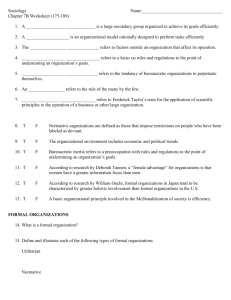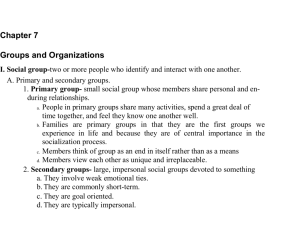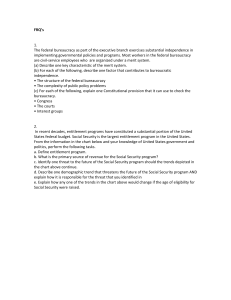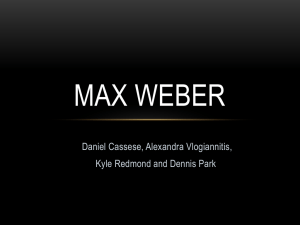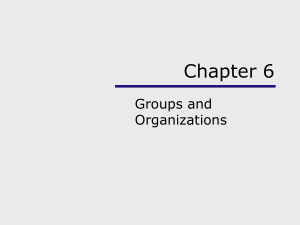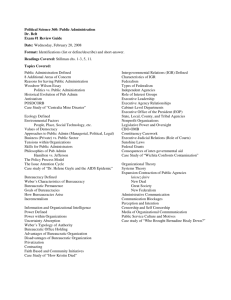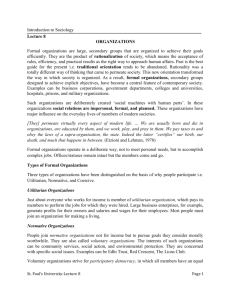Chapter 5 - IWS2.collin.edu
advertisement
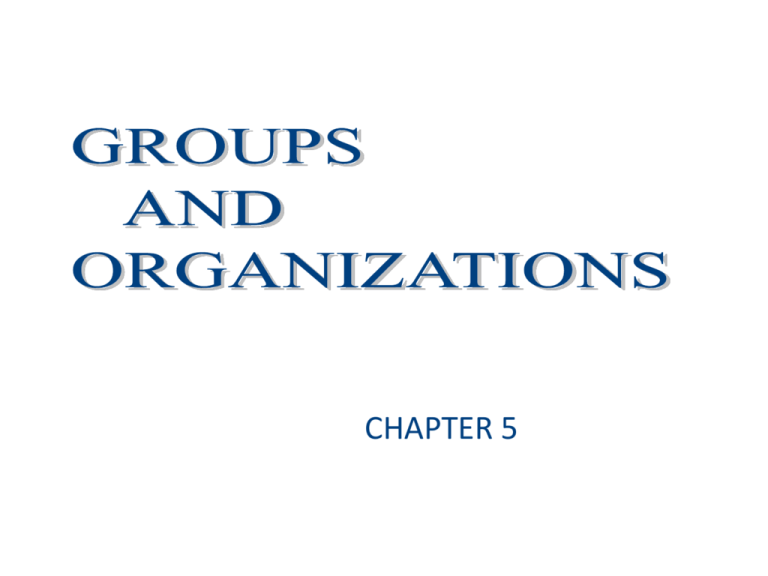
CHAPTER 5 • How do groups affect how we behave? • Why can “who you know” be as important as “what you know”? • In what ways have large business organizations changed in recent decades? • SOCIAL GROUPS – The clusters of people with whom we interact in our daily lives • FORMAL ORGANIZATIONS – Huge corporations and other bureaucracies SOCIAL GROUPS • Two or more people who identify with one another • Groups contain people with shared experiences, loyalties, and interests • Not every collection of individuals forms a group • The right circumstances can turn a crowd into a group Primary and Secondary Groups • Two types of social groups – PRIMARY GROUP • A small social group whose members share personal and lasting relationships – SECONDARY GROUP • A large and impersonal social group whose members pursue a specific goal or activity • Primary group relationships spend a great deal of time together • These personal and tightly integrated groups are the among the first experienced in life • Members of primary groups think of their group as an end in itself rather than as a means to other ends • Members view each other as unique and irreplaceable • Secondary relationships involve weak emotional ties and little personal knowledge of one another • Include many more people than primary groups • Passage of time can transform a group from secondary to primary • Members do not think of themselves as “we” • Primary groups display a personal orientation • Secondary groups have a goal orientation • Primary group members define each other according to who they are in terms of family ties or personal qualities • Secondary groups look to one another for what they are – What they can do for each other • Traits define the two groups in ideal terms • Most real groups contain elements of both Group Leadership • Important element of group dynamics is leadership • TWO LEADERSHIP ROLES – Instrumental Leadership – Expressive Leadership • Instrumental Leadership – Group leadership that focuses on the completion of tasks • Make plans • Give orders • Get things done • Expressive Leadership – Group leadership that focuses on the group’s well-being • Less of an interest in achieving goals • Focus on promoting the well-being of members • Minimize tension and conflict among members • Instrumental leaders usually have formal, secondary relationships with other members • Expressive leaders build more personal, primary ties • Successful instrumental leaders enjoy more respect from members • Expressive leaders receive more personal affection • THREE LEADERSHIP STYLES – Authoritarian Leadership • • • • • Focuses on instrumental concerns Takes personal charge of decision making Demands that group members obey orders Win little affection from the group Is appreciated in a crisis – Democratic Leadership • • • • More expressive Includes everyone in the decision-making process Less successful in a crisis situation Draw on the ideas of all members to develop creative solutions to problems – Laissez-faire Leadership • Allows group to function on its own • “Laissez-faire” – French, meaning “leave it alone” • Least effective in promoting group goals Group Conformity • Groups influence the behavior of their members – Promoting conformity • Solomon Asch and Stanley Milgram – Even strangers can encourage group conformity • Asch’s Research – Found that many of us are willing to compromise our own judgment to avoid the discomfort of being different, even from people we don’t know • Milgram’s Research – People are likely to follow the directions not only of legitimate authority figures but also of groups of ordinary individuals, even when it means harming another person • Irving L. Janis’s “Groupthink” – GROUPTHINK • The tendency of group members to conform, resulting in a narrow view of some issue – – – – Pearl Harbor, WWII Vietnam War Bay of Pigs, Cuba Iraq, 2003 Reference Groups • A social group that serves as a point of reference in making evaluations and decisions – Used to assess our own attitudes and behavior – We also use groups we do not belong to for reference – Conforming to groups we do not belong is a strategy to win acceptance • Samuel A. Stouffer’s Research – We do not make judgments about ourselves in isolation – We do not compare ourselves with just anyone – In absolute terms, we form a subjective sense of our well-being by looking at ourselves relative to specific reference groups In-Groups and Out-Groups • IN-GROUP – A social group toward which a member feels respect and loyalty • OUT-GROUP – A social group toward which a person feels a sense of competition or opposition • Based on the idea that we have valued traits they lack • Tensions between groups sharpen the group’s boundaries and give people a clearer social identity • Members of in-groups hold overly positive views of themselves and unfairly negative views of various out-groups • Powerful in-group can define others as a lowerstatus out-group • Many white people view people of color as an out-group • In terms of in-groups and out-groups, explain what happens when people who may not like each other discover they have a common enemy. Group Size • Group size plays a crucial role in how group members interact • THE DYAD – A social group with two members – Social interaction is more intense than in larger groups – Unstable, if either member withdraws, the group collapses • THE TRIAD – A social group with three members • More stable than a dyad • As groups grow beyond three people, they become more stable and capable of withstanding the loss of one or more members • Reduces intense interaction • Based less on personal attachments and more on formal rules and regulations Social Diversity: Race, Class, and Gender • Race, ethnicity, class, and gender, play a part in group dynamics • Three ways in which social diversity influences intergroup contact: – Large groups turn inward – Heterogeneous groups turn outward – Physical boundaries create social boundaries • LARGE GROUPS TURN INWARD – The larger a group, the more likely its members are to concentrate relationships among themselves – Efforts to promote social diversity may have the unintended effect of promoting separatism • HETEROGENEOUS GROUPS TURN OUTWARD – The more socially diverse a group is, the more likely its members are to interact with outsiders • PHYSICAL BOUNDARIES CREATE SOCIAL BOUNDARIES – To the extent that a social group is physically segregated from others, its members are less likely to interact with other people Networks • A web of weak social ties • A “social web” expanding outward – Reaching great distances and including large numbers of people • Some come close to being groups • More commonly includes people we know of or who know of us but with whom we interact rarely • Network ties may be weak, but they can be a powerful resource • Based on people’s colleges, clubs, neighborhoods, political parties, and personal interests • “Privileged” networks are a valuable source of “social capital” • Gender shapes networks – Women include more relatives (and more women) – Men include more co-workers (and more men) – Women’s ties are not as powerful as typical “old boy” networks – As gender equality increases, male and female networks are becoming more alike FORMAL ORGANIZATIONS • Large secondary groups organized to achieve their goals efficiently • Differ in their impersonality and their formally planned atmosphere • To carry out most of the tasks of organizing the 300 million members of U.S. society, reliance is on formal organizations Types of Formal Organizations • Three types of formal organizations • Distinguished by the reasons people participate in them – Utilitarian Organizations – Normative Organizations – Coercive Organizations • UTILITARIAN ORGANIZATIONS – Just about everyone who works for income belongs to this type of organization – Pays people for their efforts – Joining is usually a matter of individual choice – Most people must join to make a living • NORMATIVE ORGANIZATIONS – Sometimes called voluntary organizations – People join to pursue some goal they think is morally worthwhile – People in the U.S. and other high income countries are most likely to join • COERCIVE ORGANIZATIONS – Involuntary memberships – People are forced to join as a form of punishment or treatment – Have special physical features – Isolate people for a period of time to change their attitudes and behaviors Origins of Formal Organizations • Date back thousands of years • Early organizations had two limitations – Lacked technology – Pre-industrial societies they were trying to rule had traditional cultures • TRADITION – Values and beliefs passed from generation to generation • Tradition makes a society conservative – It limits an organization’s efficiency and ability to change • RATIONALITY – A way of thinking that emphasizes deliberate, matter-of-fact calculation of the most efficient way to accomplish a particular task • RATIONALIZATION OF SOCIETY – The historical change from tradition to rationality as the main mode of human thought Characteristics of Bureaucracy • BUREAUCRACY – An organizational model rationally designed to perform tasks efficiently – Official regularly create and revise policy to increase efficiency • Six key elements of ideal bureaucratic organizations – Specialization • Assigns individuals to highly specialized jobs – Hierarchy of Offices • Arrange workers in vertical ranking – Rules and Regulations • Rationally enacted rules and regulations guide operation – Technical Competence • Officials have the technical competence to carry out duties • Typically hire new members according to set standards and monitors performance – Impersonality • Puts rules ahead of personal whim • Both clients and workers are treated the same – Formal, Written Communications • Heart of bureaucracy is not the people but paperwork • Depend on formal, written memos and reports, which accumulate in vast files • Bureaucracies carefully hires workers and limits the unpredictable effects personal taste and opinion Organizational Environment • Factors outside an organization that affect its operations – FACTORS • • • • • Technology Economic and political trends Current events Available workforce Other organizations • TECHNOLOGY – Shapes modern organizations • ECONOMIC AND POLITICAL TRENDS – All organizations are helped or hurt by periodic economic growth or recession – Most industries also face competition from abroad as well as changes in law • CURRENT EVENTS – Significant effect on organizations that are far away • POPULATION PATTERNS – Average age, typical level of education, social diversity, and size of a local community • Determines the available workforce and market for products or services • OTHER ORGANIZATIONS – Contributes to the organizational environment THE INFORMAL SIDE OF BUREAUCRACY • In real-life organizations, humans are creative enough to resist bureaucratic regulation • Informality may cut corners but it also provides the flexibility necessary for change • Informality comes from the varying personalities of organizational leaders • Qualities and quirks of individuals can have an effect on organizational success or failure • Leaders sometimes seek to benefit personally through abuse of organizational power • Communication is another source of organizational informality • E-mail has allowed even the lowest-ranking employee to bypass supervisors PROBLEMS OF BUREAUCRACY • Can dehumanize and manipulate • Some say it poses a threat to political democracy • BUREAUCRATIC ALIENATION – Potential to dehumanize the people it serves – Impersonality that fosters efficiency also keeps officials and clients from responding to each other’s unique needs – Formal organizations create alienation • Reduces human beings to “small cogs in a ceaselessly moving mechanism” • Designed to benefit humanity but people might end up serving formal organizations – BUREAUCRATIC INEFFICIENCY AND RITUALISM • Bureaucratic Inefficiency – The failure of a formal organization to carry out the work it exists to perform – “Red Tape” – important work does not get done • Bureaucratic Ritualism – A focus on rules and regulations to the point of interfering with an organization’s goals – Rules and regulations should be a means to and end, not an end in themselves • BUREAUCRATIC INERTIA – The tendency of bureaucratic organizations to perpetuate themselves • OLIGARCHY – The rule of the many by the few – “Iron law of oligarchy” • Pyramid shape of bureaucracy places a few leaders in charge of the resources of the entire organization • Bureaucracy helps distance officials from the public THE EVOLUTION OF FORMAL ORGANIZATIONS • Problems of bureaucracy stem from two organizational traits – Hierarchy – Rigidity • Bureaucracy is a top-down system – Rules and regulations are made at the top – Guide every part of people’s work down the chain of command Scientific Management • The application of scientific principles to the operation of a business or other organization • Involves three steps: – Managers observe job performance, identify operations involved, and measure the time needed for each – Managers analyze data and discover ways to improve job efficiency – Management provides guidance and incentives to increase efficiency • Principles of scientific management suggest that decision-making power should rest with the owners and executives • Formal organizations now face the challenges of: – Race and gender – Rising foreign competition – Changing nature of work itself The First Challenge: Race and Gender • In the 1960’s, critics claimed big businesses engaged in unfair hiring practices – Routinely excluded women and other minorities from positions of power • PATTERNS OF PRIVILEGE AND EXCLUSION – Excluding women and minorities ignores the talents of more than half the population – Open organization encourages leaders to seek out ideas of all employees • THE “FEMALE” ADVANTAGE – Patterns which help companies strive to be more flexible and democratic • Women have greater communication skills • Women are more flexible leaders • Women emphasize the interconnectedness of all organizational operations The Second Challenge: The Japanese Work Organization • Japanese organizations reflect that nation’s strong collective spirit • Value cooperation • Hired new workers in groups – Everyone had same salary and responsibilities – Fostered a sense of loyalty – Trained workers in all phases of operations – Involved workers in “quality circles” – Companies played a large role in the lives of workers The Third Challenge: The Changing Nature of Work • U.S. economy moved from industrial to postindustrial production – Using electronic technology to create or process information • Differences: – Creative freedom – Competitive work teams – A flatter organization – Greater flexibility – Postindustrial economy created two different types of work: • Highly skilled creative work • Low-skilled service work The “McDonaldization” of Society • A symbol of U.S. culture • “McDonaldized” – Organizational principles are coming to dominate our entire society – Aspects of life are modeled on the restaurant chain • McDonaldization: Three Principles – Efficiency – Uniformity – Control • Principles limits human creativity, choice, and freedom • “The ultimate irrationality of McDonaldization is that people could lose control over the system and it would come to control us.” THE FUTURE OF ORGANIZATIONS: OPPOSING TRENDS • Postindustrial economy created more routine service jobs • “McJobs” offer few benefits that today’s highly skilled workers enjoy • Global competition attract creative employees but costs are cut by eliminating many routine jobs • Some people are better off than others
